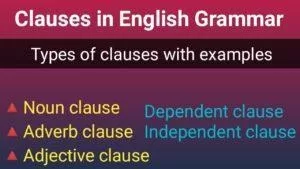
Clause in English grammar. Types of clauses in English grammar with examples. Clauses in English grammar in Kannada.
To get more video notes for competitive exams visit our YouTube channel. This channel is very useful for all competitive exams.
What is a clause?
A clause is a group of words that has both a subject and a predicate. Every complete sentence is made up of at least one clause. A clause conveys information about what that subject is or is doing.
Example:
1. John bought a new car. (One sentence, one clause)
2. John bought a new car, but he still has the old one. (One sentence, two clauses)
3. Although he still has his old one, John now has a new car. (One sentence, two clauses)
Types of clauses:
There are two types in clauses. They are as following.
1. Independent clause
2. Dependent clause
1. Independent clause:
An independent clause (or main clause) makes sense by itself. It expresses a complete thought.
E.g: The waves crashed onto the sandy shore.
The sentence above is an example of an independent clause because it expresses a complete thought and contains both a subject, the waves, and a predicate, crashed onto the sandy shore.
Example:
1. John bought a new car. (One independent clause)
2. John bought a new car, but he still has the old one. [Two independent clauses (Coordinating conjunctions don’t count as part of the clause.)]
3. Although he still has his old one, John now has a new car. (Only the second clause is independent.)
2. Dependent clause:
A dependent clause (or subordinate clause) does not make sense by itself. It does not express a complete thought.
For example: This is the letter that I gave him.
In the sentence above, the dependent clause “that I gave him” modifies the subject, “this”, by adding specific details.
Example:
1. Although he still has his old one. (Without the independent clause, a dependent clause is a sentence fragment.)
2. When the president arrives
3. Whenever you come to visit
Types of Dependent clause:
There are three main types of dependent clauses. They are as following.
1. Relative clause (adjective clause)
2. Noun clause
3. Adverbial clause
1. Relative clause (adjective clause):
A relative clause is an adjective clause that describes the noun. It is important to remember that a relative clause is not a complete thought! They are used in sentences to further describe the noun. And usually begin with a relative pronoun and sometimes with a subordinating conjunction.
Example:
1. The flowers that we picked up last month have died.
2. Mohan’s cat that ate the mouse had a stomach ache.
3. The book that is on the chair belongs to Shreya.
4. The boy whose shoes are on the floor is my little brother.
5. The lady who lives across the street is my aunt.
2. Noun clause:
A noun clause is a dependent clause that acts like a noun. It serves the exact same function as a noun. It can be a subject, object, or complement. Like the relative clause, a noun clause usually begins with a relative pronoun. However, it can also begin with a subordinate conjunction. Remember, like other dependent clauses, a noun clause will not stand alone!
Example:
1. What the girl did was not very helpful.
2. I can’t figure out why she said that.
3. We will do whatever is necessary.
4. The trophy goes to whoever wins the race.
5. Please tell me who left his shoes on the floor.
3. Adverbial clause: An adverb clause is a dependent clause that describes a verb, an adjective, or an adverb. An adverb clause tells when, where, how, why, to what extent, or under what conditions something happened.
eXAMPLES FOR ADVERBIAl clause:
1. Unless you run fast, you will miss the bus.
2. Before we go on vacation, we must make reservations.
3. My sister, when she is angry, will turn red in the face.
4. Give us a call when you get back from your trip.
5. Mark will sit where he always sits.
Watch this video for the explanation of Clause in English grammar.